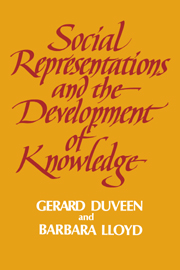Book contents
- Frontmatter
- Contents
- List of figures
- List of tables
- List of contributors
- Acknowledgements
- 1 Introduction
- 2 The underlife of the nursery school: young children's social representations of adult rules
- 3 A semiotic analysis of the development of social representations of gender
- 4 Children's representations of social relations
- 5 Social representations of childhood: an implicit theory of development
- 6 What is in an image? The structure of mothers' images of the child and their influence on conversational styles
- 7 The acquisition of reflexive social emotions: the transmission and reproduction of social control through joint action
- 8 From social cognition to social representations in the study of intelligence
- 9 Prototypes of the psychologist and professionalisation: diverging social representations of a developmental process
- 10 Social psychology and developmental psychology: extending the conversation
- Author index
- Subject index
1 - Introduction
Published online by Cambridge University Press: 08 March 2010
- Frontmatter
- Contents
- List of figures
- List of tables
- List of contributors
- Acknowledgements
- 1 Introduction
- 2 The underlife of the nursery school: young children's social representations of adult rules
- 3 A semiotic analysis of the development of social representations of gender
- 4 Children's representations of social relations
- 5 Social representations of childhood: an implicit theory of development
- 6 What is in an image? The structure of mothers' images of the child and their influence on conversational styles
- 7 The acquisition of reflexive social emotions: the transmission and reproduction of social control through joint action
- 8 From social cognition to social representations in the study of intelligence
- 9 Prototypes of the psychologist and professionalisation: diverging social representations of a developmental process
- 10 Social psychology and developmental psychology: extending the conversation
- Author index
- Subject index
Summary
Social representations as a perspective in social psychology
The concept of social representations introduced into social psychology by Moscovici and his collaborators has had a chequered reception in the English speaking world. It is in La Psychanalyse, son image et son public that Moscovici (1976a) elaborated the concept of social representation most fully, both theoretically and empirically. In the absence of a translation, even Moscovici's own English presentations of the concept have an abstract, general or programmatic character, since they introduce a theoretical perspective without the benefit of a clear demonstration of its value for empirical research (see Moscovici, 1973, 1981, 1983, 1984, 1988; Moscovici and Hewstone, 1983).
In calling the first chapter of his book ‘Social representation: a lost concept’ Moscovici implies that social psychology has become disengaged from a concern with the situation of psychological processes in social life. The concept of social representation is intended to restore to social psychology an awareness of the social by providing the means for comprehending social life from a psychological perspective. Such a perspective is a necessary prerequisite for understanding the influence of social relations on psychological processes.
Moscovici defines social representations as
system(s) of values, ideas and practices with a twofold function; first, to establish an order which will enable individuals to orient themselves in their material and social world and to master it; and secondly to enable communication to take place among the members of a community by providing them with a code for social exchange and a code for naming and classifying unambiguously the various aspects of their world and their individual and group history.
(Moscovici, 1973, p. xiii)- Type
- Chapter
- Information
- Publisher: Cambridge University PressPrint publication year: 1990
- 41
- Cited by

